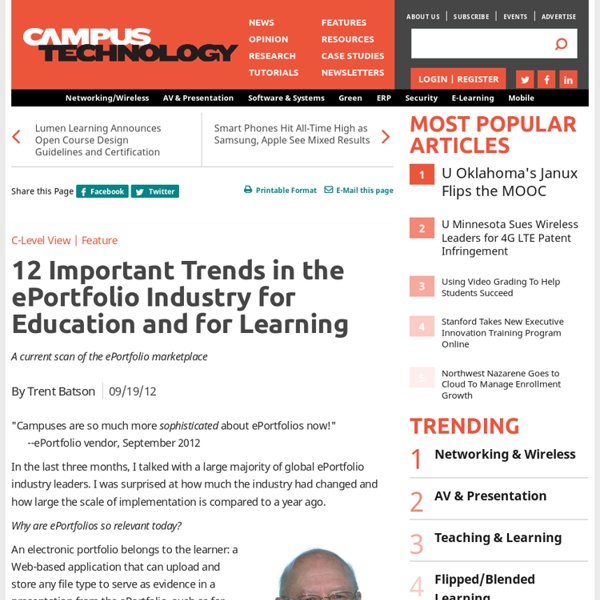REAL ePortfolio Academy
It has become apparent that there is a need for multiple courses, meant to answer three questions about Electronic Portfolios in K-12 Schools: What? (Definition, Description, Examples) Why? (Purpose, Benefits, Philosophy) How? (Implementation Strategies, Pedagogy, Promising Practices). In summary, the following courses are planned: a generic, tool-neutral short course that provides an overview of electronic portfolios; a more in-depth course that supports specific implementation with students using Google Apps (later, a course on WordPress/EduBlogs may be offered, if there is enough interest); a course on creating a digital narrative/story to add voice to e-portfolios; a course to build a professional portfolio (may be taken simultaneously with overview course); and a course to support classroom-based research on implementation of electronic portfolios.
Crossing the threshold: moving e-portfolios into the mainstream
1 View or download this publication in accessible PDF format2 What the publication offers Despite pockets of good practice across the disciplines, wide-scale adoption of e-portfolios across further and higher education institutions has been less commonly achieved, and where large-scale implementation has occurred, little has been shared to inform the work of others. Now a JISC-funded e-Portfolio Implementation Toolkit and a series of institutional video case studies have brought together information and guidance from institutions with experience of e-portfolio implementation to assist universities, colleges and other organisations planning to mainstream their use of e-portfolios. Crossing the Threshold is a short publication which follows the stages of a typical implementation journey, synthesising insights and guidance from the toolkit and supporting case studies to form a summary of good practice at each stage of the process. Further information
How to Create a Portfolio with Evernote (Education Series)
Bio Rob is a teacher at Trillium Charter School in Portland, where he primarily instructs students aged 8-11. He has been working to develop online portfolios with students for the past six years and has taught in private schools, traditional public schools and public charter schools for the past 15 years. I use Evernote, Everywhere: iPhoneiPod TouchiPadMacWindows E-Portfolios: a student’s project warehouse and progress tracker I started teaching 15 years ago and that is when I first came across this concept of a ‘portfolio.’ Initially, I had my students create paper portfolios. We had a bin where we’d put these documents and at the end of the year, they’d have 10-20 pieces that they’d take with them into the next school year. After spending years with paper portfolios, I’ve transitioned this concept into digital form, and have started to implement Evernote as the primarily system for creating portfolios in my classroom. Evernote as an portfolio system Parent/Teacher conferences and Evernote
Online Portfolio Tools
Much of this work began with my Online Portfolio Adventure, where I recreated my presentation portfolio with at least 33 different online services, software and strategies between September 2004 and the present time. In 2006, I began exploring the use of Web 2.0 tools, and constructed portfolios using these tools. One advantage of Web 2.0 tools is that many of them are free, although WikiSpaces may place ads on the page. There is some concern about security in a K-12 school environment, so care should be taken when using these tools with children.
UnivAcademicAffairs information
Home - FolioSpaces free ePortfolio - 2GB free storage - free institutional hosting - teachers - students - school - college - university
E-Portfolios: Go Big or Go Home
Darren Cambridge (dcambridge@air.org) is Senior Consultant, Education Technology and Online Communities of Practice, at the American Institutes for Research, is Co-Director of the Inter/National Coalition for Electronic Portfolio Research, and is winner of the MacArthur Foundation Digital Media and Learning Faculty Prize. Comments on this article can be posted to the web via the link at the bottom of this page. As recently as five years ago, many of the CIOs and directors of academic technology with whom I spoke saw e-portfolio implementation as a significant challenge. It was a complex undertaking, and there was much uncertainty about available products, policy, and support. I have spent the last fifteen years researching, developing, and teaching and learning with e-portfolio technologies and practices. At the departmental level, the most common use of e-portfolios is to gather artifacts of student work to demonstrate fulfillment of standards as a component of programmatic assessment.
JISC Guide... Using digital media for your eportfolio
e-Portfolios are an important part of many learners' academic life. This advice document introduces the concept of an e-Portfolio and explains how digital media can be used effectively. Introduction There are many definitions of what constitutes an e-Portfolio. Looking at the commonalities in a range of definitions gives us a simplified definition: an e-Portfolio is a number of independent digital artefacts that are grouped together to demonstrate a range of skills and competencies of the creator. This definition is further clarified by our sister service JISC infoNet, who have an in-depth infokit on the topic of e-Portfolios and define it as: ... an e-portfolio is a product created by learners, a collection of digital artefacts articulating learning (both formal and informal), experiences and achievements. Our advice document focuses on the use of digital media as a tool to support the processes element of an e-Portfolio. Key facts Stakeholders Format of an e-Portfolio Tools or systems Mahara



